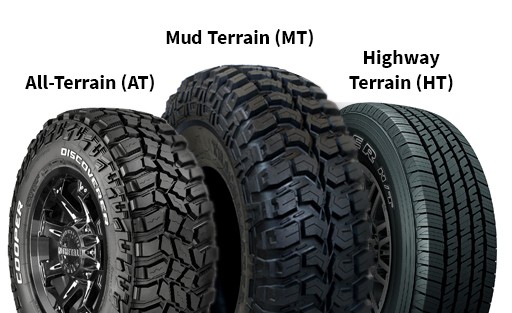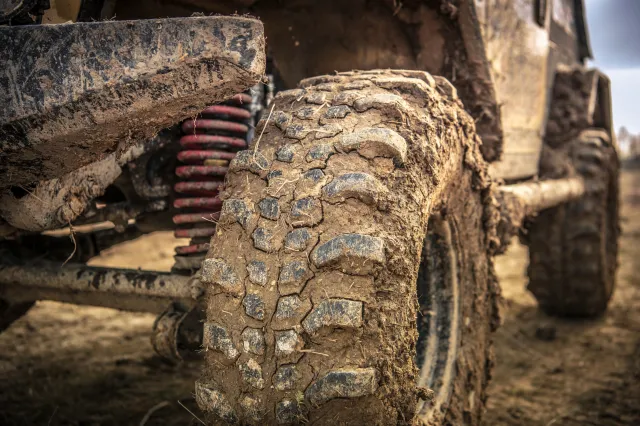Driving in muddy conditions can be tricky. If your vehicle loses traction, the wheels start spinning, and you could end up stuck in the mud.
This is a common problem for off-road drivers, truck owners, and SUV users who travel through rough terrain.
But don’t worry! You can avoid this problem with the right driving techniques, tire choices, and recovery tools.
Simple adjustments—like using the correct tire pressure for mud, keeping steady momentum, and carrying traction aids like TruckClaws™—can make a huge difference.
In this guide, we’ll show you the best ways to increase traction in mud so you can drive safely, even in the muddiest conditions.
Whether you love off-roading or just need to be prepared for unexpected muddy roads, these tips will help you stay in control and keep moving forward!
Mud can be unpredictable and challenging to drive through. The type of mud you encounter plays a big role in how your vehicle performs.
When a vehicle drives through mud, the tires struggle to maintain contact with a solid surface.
The wet and soft nature of mud causes wheels to lose grip, leading to slipping, spinning, or even sinking. Unlike dry terrain, where tires can dig in for grip, muddy surfaces often cause wheels to slide or get buried.
Regular road tires are designed for smooth, paved surfaces. They have shallow treads that cannot channel mud away, causing them to lose contact with the ground.
In contrast, mud-terrain tires have deeper, wider tread patterns that help push mud out and maintain traction. Without the right tires, vehicles are more likely to struggle in muddy conditions.

Having the right tires is one of the most important factors in maintaining traction in mud. Not all tires perform well in off-road conditions, so choosing the right type can make a huge difference.
Both mud-terrain tires and all-terrain tires are designed for off-road use, but they have key differences:
| Feature | Mud-Terrain Tires (M/T) | All-Terrain Tires (A/T) |
| Traction in Mud | Excellent – Deep tread patterns help dig through mud and push it out. | Decent – Better than regular tires but can struggle in deep mud. |
| Tread Design | Large, aggressive tread blocks with wide gaps to prevent mud buildup. | Smaller tread blocks with tighter spacing for balanced on/off-road use. |
| Durability | Built for extreme off-road conditions, including mud, rocks, and sand. | More versatile but less specialized for deep mud. |
| On-Road Comfort | Noisy and rough on pavement due to aggressive tread. | Quieter and smoother for daily driving. |
| Lifespan | Shorter due to soft rubber compound. | Longer-lasting on highways and city roads. |
If you frequently drive in muddy conditions, mud-terrain tires are the best option. However, if you need a balance between off-road capability and on-road comfort, all-terrain tires might be a better choice.
Some of the top-rated mud tires for off-road vehicles include:
Tread patterns play a huge role in how a tire handles mud. Here’s why they matter:
Choosing the right tire can make all the difference when driving through muddy terrain.
One of the easiest and most effective ways to increase traction in mud is by adjusting your tire pressure.
Lowering the PSI (pounds per square inch) increases the tire’s surface area, helping it grip the muddy terrain better.
When you reduce tire pressure, the tire becomes softer and spreads out, creating a larger contact patch with the ground. This helps in several ways:
The ideal PSI depends on the type of terrain and the weight of your vehicle. Here are some general guidelines:
| Terrain Type | Recommended PSI |
| Shallow Mud (light mud on hard-packed ground) | 20-25 PSI |
| Deep Mud (thick, wet mud) | 15-20 PSI |
| Extreme Mud & Soft Terrain (swamps, loose mud) | 10-15 PSI |
Note: Never go too low, as this can cause the tire to separate from the rim.
Once you’re back on solid ground, it’s important to reinflate your tires to their normal pressure before driving on highways. Driving with low PSI on pavement can damage your tires and reduce fuel efficiency.
A portable air compressor is a must-have for off-roaders. Simply attach it to your vehicle’s power source, connect it to the tires, and restore them to their recommended PSI for on-road driving.
Driving in muddy conditions requires a different approach than regular roads. Using the right techniques can prevent you from getting stuck and help you increase traction in mud. Here are some essential driving strategies:
One of the biggest mistakes drivers make in mud is stopping suddenly. Maintaining steady momentum helps keep the tires moving, reducing the chances of sinking into soft ground.
If your vehicle is stuck, avoid flooring the accelerator. Instead, use a rocking motion to free yourself:
Steering the right way can make a huge difference in off-road traction.
Excessive throttle can cause wheel spin, making it harder to regain traction. Instead:
By following these techniques, you can improve your chances of safely navigating muddy terrain.
Even with the best mud tires and driving techniques, getting stuck is always a possibility when off-roading.
Having the right recovery gear ensures that you can free your vehicle quickly and safely. Here’s a breakdown of the most essential traction aids and recovery tools for muddy terrain.
When you’re stuck in deep mud, TruckClaws™ light truck traction aid provide an instant solution by attaching directly to your vehicle’s tires.
While TruckClaws™ offer a fast and efficient solution, here are some other traction aids commonly used in off-road recovery:
Traction mats like Maxtrax and TRED can help, but they require manual placement and proper positioning to work effectively.
Comparing MaxTrax traction boards vs. TruckClaws can help you determine the best traction aid for your off-road needs.
For more extreme off-road recovery, advanced tools like winches and recovery ropes come in handy:
Equipping your vehicle with the right traction aids and recovery tools can save you from long hours of being stranded in muddy terrain.

For serious off-road driving, modifying your vehicle can significantly improve traction in mud. Certain upgrades enhance your vehicle’s ability to maintain grip, power through rough terrain, and avoid getting stuck.
A 4×4 drivetrain is essential for mud driving, as it distributes power to all four wheels instead of just two.
However, standard four-wheel drive (4WD) or all-wheel drive (AWD) may not always be enough in deep or sticky muddy terrain.
Modern trucks and SUVs come with traction control systems (TCS) that reduce wheel spin by applying brakes or cutting engine power. While this is helpful on pavement, it can sometimes work against you in muddy conditions.
Ground clearance is crucial when driving in slippery mud, as deeper ruts and soft surfaces can cause your vehicle to bottom out. Suspension upgrades and lift kits provide extra height to keep your undercarriage from getting stuck.
Upgrading your vehicle with these off-road modifications can make a huge difference in mud traction, helping you navigate challenging terrains with confidence.
Driving in muddy terrain comes with risks, and being properly prepared can make a huge difference in off-road safety.
Whether you’re exploring trails, working in remote areas, or dealing with extreme mud conditions, having the right gear and knowledge is essential.
Before heading into muddy off-road conditions, make sure you have the following essential gear:
Additionally, knowing how to get a DOT inspection for your truck can help you stay compliant and ensure your vehicle is in top shape before off-roading.
If you’re stuck in mud and self-recovery isn’t working, you might need outside assistance. Here’s what to do:
Being part of an off-road community can provide valuable support and knowledge. Experienced drivers can help you navigate difficult muddy trails and assist in recovery situations.
By following these off-road safety tips, you can enjoy mud driving while staying prepared for unexpected situations.

For off-road enthusiasts, nothing beats the thrill of tackling muddy trails and rough terrain. Whether you’re testing your 4×4 truck, SUV, or ATV, these top destinations offer exciting and challenging experiences for mud driving.
Moab is famous for its stunning red rock landscapes, but after rain, the dirt trails transform into mud-driving playgrounds.
With a mix of rocky obstacles and muddy sections, it’s a great spot for off-roaders looking for a challenge.
Located in California, the Rubicon Trail is one of the most well-known off-road trails in the world. It’s a favorite among Jeep and 4×4 enthusiasts, featuring deep mud ruts, rocky climbs, and water crossings.
The Australian Outback offers some of the most extreme off-road conditions, from muddy tracks to sandy deserts. This vast region is perfect for adventurous drivers looking to push their vehicles to the limit.
If you love mud driving, these destinations offer unforgettable off-road adventures. Just make sure to bring the right gear, including TruckClaws™, for a smooth recovery if you get stuck!
Driving through muddy terrain can be both exciting and challenging. Without the right techniques, tires, and recovery gear, even the most powerful 4×4 trucks and SUVs can get stuck.
By following the right strategies, you can increase traction in mud and navigate safely through difficult conditions.
Before heading into muddy terrain, take time to practice off-road recovery skills in a controlled environment.
Whether you’re exploring off-road trails or driving through deep mud, always be prepared with the right gear and safety measures.
With the right knowledge and tools, you can confidently tackle muddy conditions without fear of getting stuck. So, before your next off-road adventure, make sure your vehicle is ready for the challenge!
When you’re stuck in deep mud, having the right recovery tool can make all the difference.
TruckClaws™ is an essential emergency traction aid designed for trucks, SUVs, and commercial vehicles.
Unlike bulky traction mats or time-consuming winches, TruckClaws™ installs in minutes, providing instant traction to get your vehicle moving again.
Don’t wait until you’re stranded—add TruckClaws™ to your off-road recovery kit today and stay prepared for any muddy challenge!
